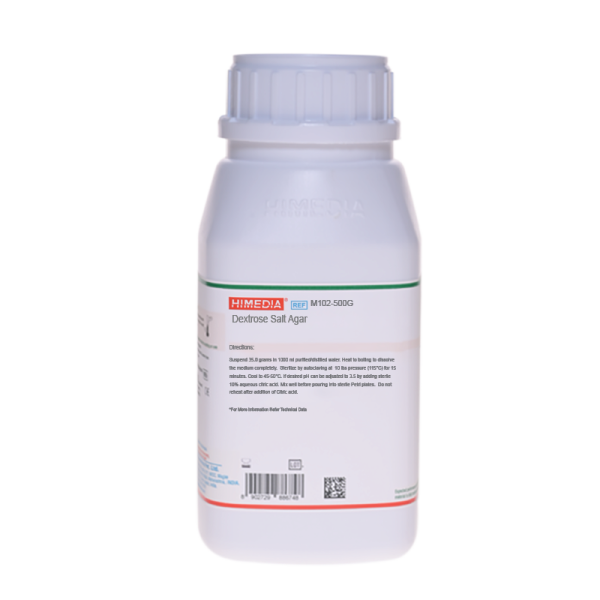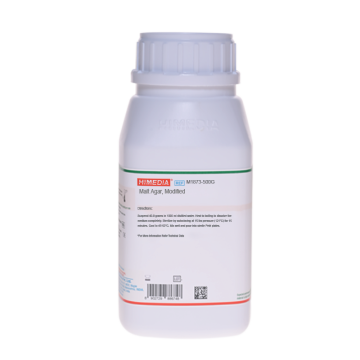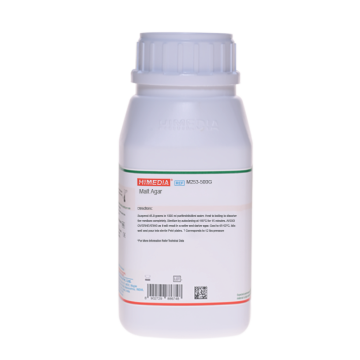 Your enquiry has been submitted
Your enquiry has been submitted
Dextrose Salt Agar
Fungi Yeasts and Molds#CC293D
Intended Use
Recommended for enumeration of yeasts and moulds in butter and other dairy products.
Composition**
| Ingredients | Gms / Litre |
|---|---|
| Dextrose (Glucose) | 10.000 |
| Yeast extract | 1.000 |
| Ammonium nitrate | 1.000 |
| Ammonium sulphate | 1.000 |
| Disodium hydrogen phosphate | 4.000 |
| Potassium dihydrogen phosphate | 2.000 |
| Sodium chloride | 1.000 |
| Agar | 15.000 |
| Final pH (at 25°C) | 6.6±0.2 |
**Formula adjusted, standardized to suit performance parameters
Directions
Suspend 35.0 grams in 1000 ml purified / distilled water. Heat to boiling to dissolve the medium completely. Sterilize by autoclaving at 10 lbs pressure (115°C) for 15 minutes. Cool to 45-50°C. If desired pH can be adjusted to 3.5 by adding sterile 10% aqueous citric acid. Mix well before pouring into sterile Petri plates. Do not reheat the medium after addition of citric acid.
Principle And Interpretation
Dextrose Salt Agar is prepared according to the standard formula 31 of the International Dairy Federation (2). It is used for enumeration of yeasts and moulds in butter and other dairy products (5,6).
Yeast extract and dextrose provide growth nutrients. A 2.5 gm sample of chilled butter is diluted with 5 ml of quarter strength Ringers solution. Plates are poured by addition of 0.2 ml of the solution, which corresponds to 0.1 gm butter. Plates are incubated at 30°C for 2 days. If growth is not visible then incubation is continued at 30°C for 3 days and visible colonies of yeasts and moulds are counted.
Type of specimen
Dairy samples
Specimen Collection and Handling:
For dairy samples, follow appropriate techniques for sample collection and processing as per guidelines (1,7).
After use, contaminated materials must be sterilized by autoclaving before discarding.
Warning and Precautions :
Read the label before opening the container. Wear protective gloves/protective clothing/eye protection/ face protection. Follow good microbiological lab practices while handling specimens and culture. Standard precautions as per established guidelines should be followed while handling specimens. Safety guidelines may be referred in individual safety data sheets.
Limitations :
- 1. Some organism may show poor growth due to nutritional variation.
Performance and Evaluation
Performance of the medium is expected when used as per the direction on the label within the expiry period when stored at recommended temperature.
Quality Control
Appearance
Cream to yellow homogeneous free flowing powder
Gelling
Firm, comparable with 1.5% Agar gel
Colour and Clarity of prepared medium
Light amber coloured, clear to slightly opalescent gel forms in Petri plates
Reaction
Reaction of 3.5% w/v aqueous solution at 25°C. pH: 6.6±0.2
pH
6.40-6.80
Cultural Response
Cultural characteristics observed after an incubation at 30°C for 48-72 hours.
| Organism | Inoculum (CFU) | Growth | Recovery |
|---|---|---|---|
| #Aspergillus brasiliensis ATCC 16404 (00053*) | 50-100 | good-luxuriant | |
| Candida albicans ATCC 10231 (00054*) | 50-100 | good-luxuriant | >=50% |
| Saccharomyces cerevisiae ATCC 9763 (00058*) | 50-100 | good-luxuriant | >=50% |
Key: *Corresponding WDCM numbers. # - Formerly known as Aspergillus niger
Storage and Shelf Life
Store between 10-30°C in a tightly closed container and the prepared medium at 20-30°C. Use before expiry date on the label. On opening, product should be properly stored dry, after tightly capping the bottle in order to prevent lump formation due to the hygroscopic nature of the product. Improper storage of the product may lead to lump formation. Store in dry ventilated area protected from extremes of temperature and sources of ignition Seal the container tightly after use. Product performance is best if used within stated expiry period.
Disposal
User must ensure safe disposal by autoclaving and/or incineration of used or unusable preparations of this product. Follow established laboratory procedures in disposing of infectious materials and material that comes into contact with clinical sample must be decontaminated and disposed of in accordance with current laboratory techniques (3,4).
Reference
- American Public Health Association, Standard Methods for the Examination of Dairy Products, 1978, 14th Ed., Washington D.C.
- International Dairy Federation, 1964, International Standard FIL-1 DF31 Brussels.
- Isenberg, H.D. Clinical Microbiology Procedures Handbook 2nd Edition.
- Jorgensen, J.H., Pfaller, M.A., Carroll, K.C., Funke, G., Landry, M.L., Richter, S.S and Warnock., D.W. (2015) Manual of Clinical Microbiology, 11th Edition. Vol. 1.
- Ritter and Eschmann, 1966, Alimenta., 5:43.
- Ritter and Eschmann, 1966, Alimenta., 5:46.
- Wehr H. M. and Frank J. H., 2004, Standard Methods for the Microbiological Examination of Dairy Products, 17th Ed., APHA Inc., Washington, D.C.
| Product Name | Dextrose Salt Agar |
|---|---|
| SKU | M102 |
| Product Type | Regular |
| Physical Form | Powder |
| Origin | Animal Free (Microbial) |
| Packaging type | HDPE |
| References | 1. International Dairy Federation, 1964, International Standard FIL-1 DF31 Brussels. 2.Ritter and Eschmann, 1966, Alimenta., 5:43. 3.Ritter and Eschmann, 1966, Alimenta., 5:46. |
| Customized Product Available | No |






